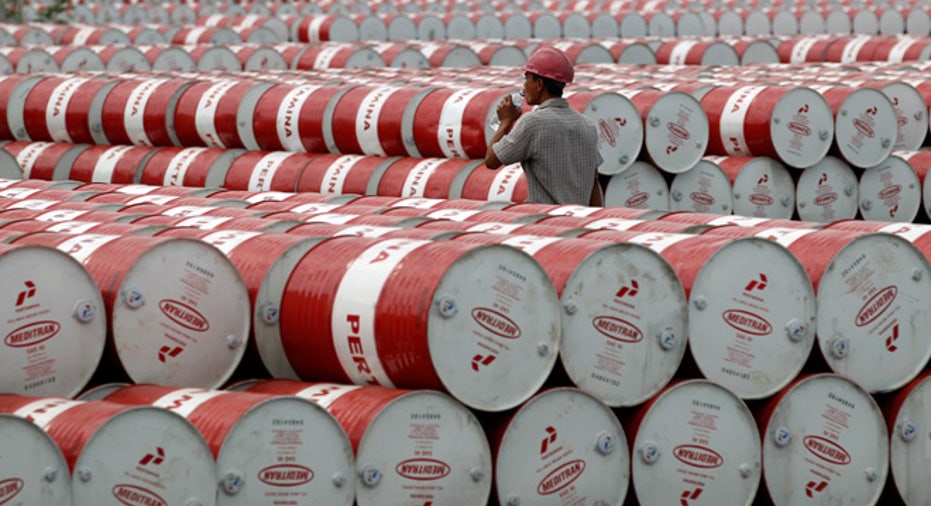Saudi Arabia Squeezed by Oil Swoon

Saudi Arabia is getting squeezed by oil’s year-long slump.
Citing oil prices, Fitch lowered its outlook for Saudi Arabia’s sovereign debt to negative. The ratings agency believes the fall of global crude, in addition to increased government spending, will widen the nation’s general budget deficit to 14.4% of GDP in 2015.
The International Monetary Fund issued a worse forecast in June, saying Saudi Arabia may book a deficit equal to 20% of its economic output this year.
Global oil prices have plunged by more than 60% from their highs in 2014 amid a supply glut and growing concerns over demand, especially from China. In a surprise move, OPEC opted to maintain production levels, and for Saudi Arabia, oil output has soared to record highs. Many analysts expected the oil cartel to ease the flow of OPEC crude to lift pricing.
Brent crude, the international benchmark, is now trading around $43.44 a barrel compared to over $60 a barrel in June. Nymex West Texas Intermediate futures remained below the $40 mark at $39.45 a barrel Tuesday.
!function(d,s,id){var js,fjs=d.getElementsByTagName(s)[0],p=/^https:/.test(d.location)?'https':'http';if(!d.getElementById(id)){js=d.createElement(s);js.id=id;js.src=p+"://cdn1.findthebest.com/rx/widgets.js";fjs.parentNode.insertBefore(js,fjs);}}(document,"script","ftb-widgetjs");
Saudi Arabia, the world’s largest oil exporter, has transitioned away from oil over the years, although the country is still very reliant on the energy sector. In 2014, oil and natural gas accounted for just under 40% of Saudi Arabia’s GDP.
However, by limiting its dependence on oil revenue, Saudi Arabia has so far avoided the kind of economic downswing that was common during past oil slumps. IHS Global Insight projects Saudi Arabia’s non-oil growth to slow from 5.4% last year to 3.1% in 2015.
The decline “is not as dramatic as it has been,” said economist Bryan Plamondon, the director of IHS’s Middle East and North Africa group.
“Oil production is growing at a faster pace this year, which is buoying headline GDP growth,” Plamondon added, noting how cuts to oil production amid the global financial crisis in 2009 weighed on the Saudi Arabian economy.
To that point, the IMF said Saudi Arabia should be able to maintain economic growth of around 3.5% in 2015, roughly level with the prior year.
The oil market’s downswing is more likely to impact Saudi Arabia’s fiscal and current accounts. Saudi Arabia posted a fiscal deficit last year for the first time since 2002. IHS believes Saudi Arabia will not run a current account deficit this year, or a negative balance for trade, which has not happened since 1998.
The energy industry will be watching OPEC closely ahead of the oil cartel’s next meeting in December. Saudi Arabia led the decision to maintain production levels, but the nation could backtrack if the fiscal pain is considered too great.
“The Kingdom has been the driver of the OPEC strategy of trying to force the burden of adjustment onto other producers and not defending a price floor for oil,” analysts at RBC Capital Markets wrote in a note to clients in early August.
Saudi Arabia has sustained high levels of spending, including foreign policy initiatives, by “drawing down its ample reserves and resorting to borrowing,” RBC added.
OPEC’s decision to keep the spigots open was seen as a bet that U.S. producers, especially companies investing in shale oil, would limit production. The industry has certainly scaled back over the last year, yet domestic oil output continues at a strong pace.
Analysts are waiting for signs that cuts in the U.S. or other oil-producing countries like Russia will soften the existing supply glut.
“OPEC will most likely keep quotas where they are,” Plamondon said. “With oil prices at the level they are now, if they persist and we don’t see some correction later this year when high-cost producers are taken offline, it may prompt OPEC to revisit.”



















